Analyzing Climate Change's Effect on Business Sustainability: Report
VerifiedAdded on 2023/06/08
|11
|3135
|410
Report
AI Summary
This report explores the critical link between climate change and business operations. It begins by discussing the scientific evidence for climate change, including global warming and extreme weather events, and evaluates the challenges these pose to businesses worldwide, such as increased costs, supply chain disruptions, and changes in consumer behavior. The report also examines the attributes and capabilities essential for business success in a complex and changing environment, including unique value propositions, customer-centric approaches, strong vision, empowered employees, passionate leadership, effective marketing, and diversity. The conclusion emphasizes the importance of sustainability and adaptation strategies for businesses to thrive in the face of climate change. This report is a contribution to Desklib, a platform providing AI-driven study tools.
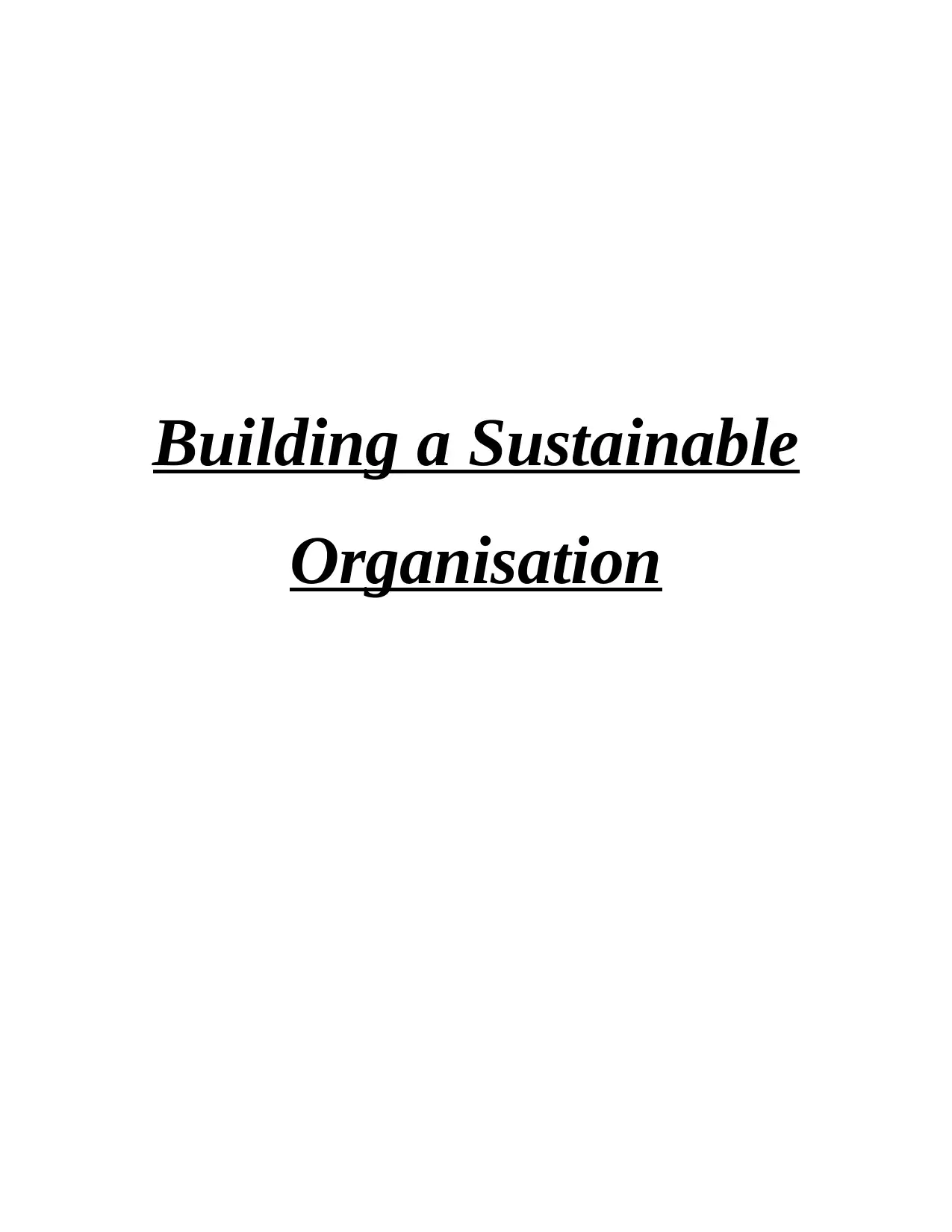
Building a Sustainable
Organisation
Organisation
Paraphrase This Document
Need a fresh take? Get an instant paraphrase of this document with our AI Paraphraser
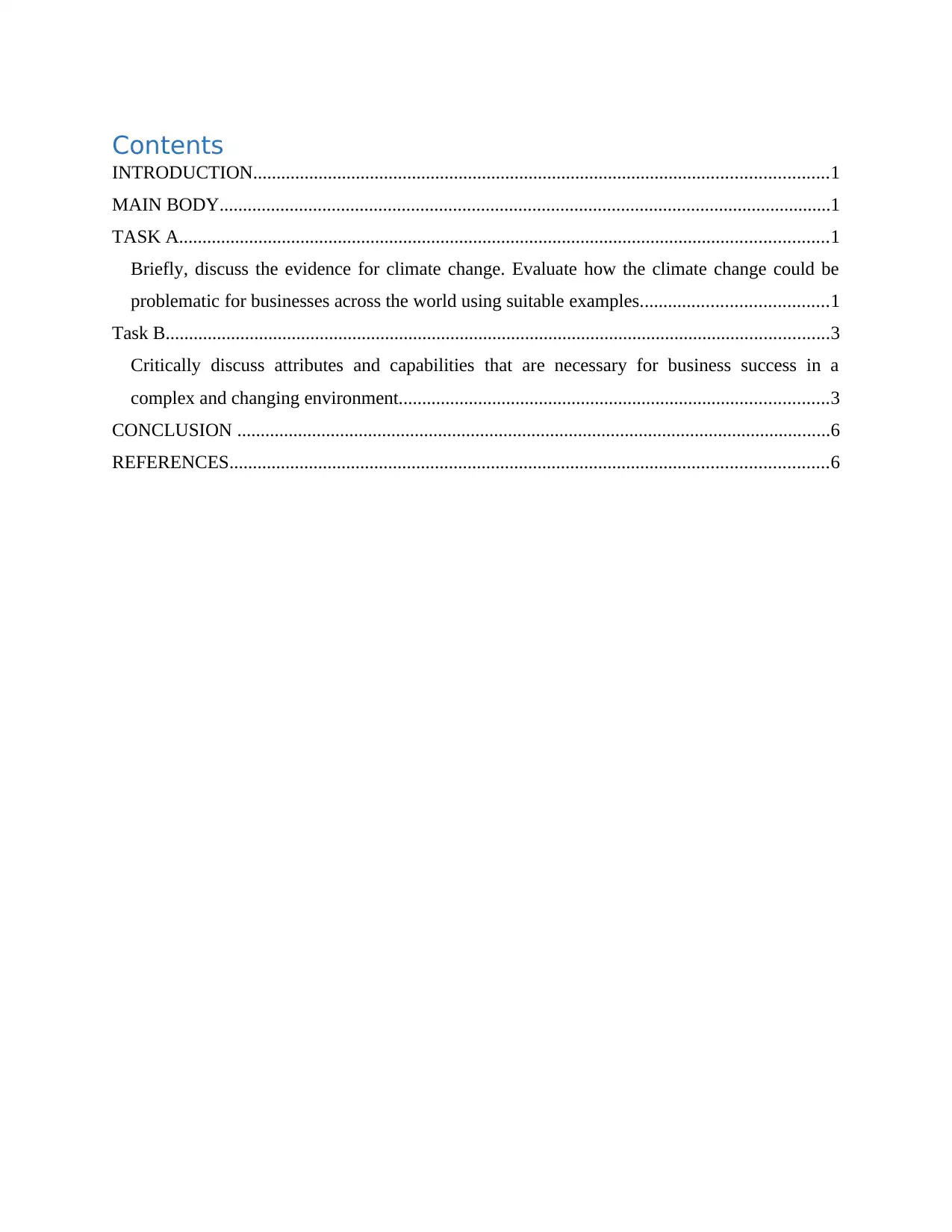
Contents
INTRODUCTION...........................................................................................................................1
MAIN BODY...................................................................................................................................1
TASK A...........................................................................................................................................1
Briefly, discuss the evidence for climate change. Evaluate how the climate change could be
problematic for businesses across the world using suitable examples........................................1
Task B..............................................................................................................................................3
Critically discuss attributes and capabilities that are necessary for business success in a
complex and changing environment............................................................................................3
CONCLUSION ...............................................................................................................................6
REFERENCES................................................................................................................................6
INTRODUCTION...........................................................................................................................1
MAIN BODY...................................................................................................................................1
TASK A...........................................................................................................................................1
Briefly, discuss the evidence for climate change. Evaluate how the climate change could be
problematic for businesses across the world using suitable examples........................................1
Task B..............................................................................................................................................3
Critically discuss attributes and capabilities that are necessary for business success in a
complex and changing environment............................................................................................3
CONCLUSION ...............................................................................................................................6
REFERENCES................................................................................................................................6

⊘ This is a preview!⊘
Do you want full access?
Subscribe today to unlock all pages.

Trusted by 1+ million students worldwide
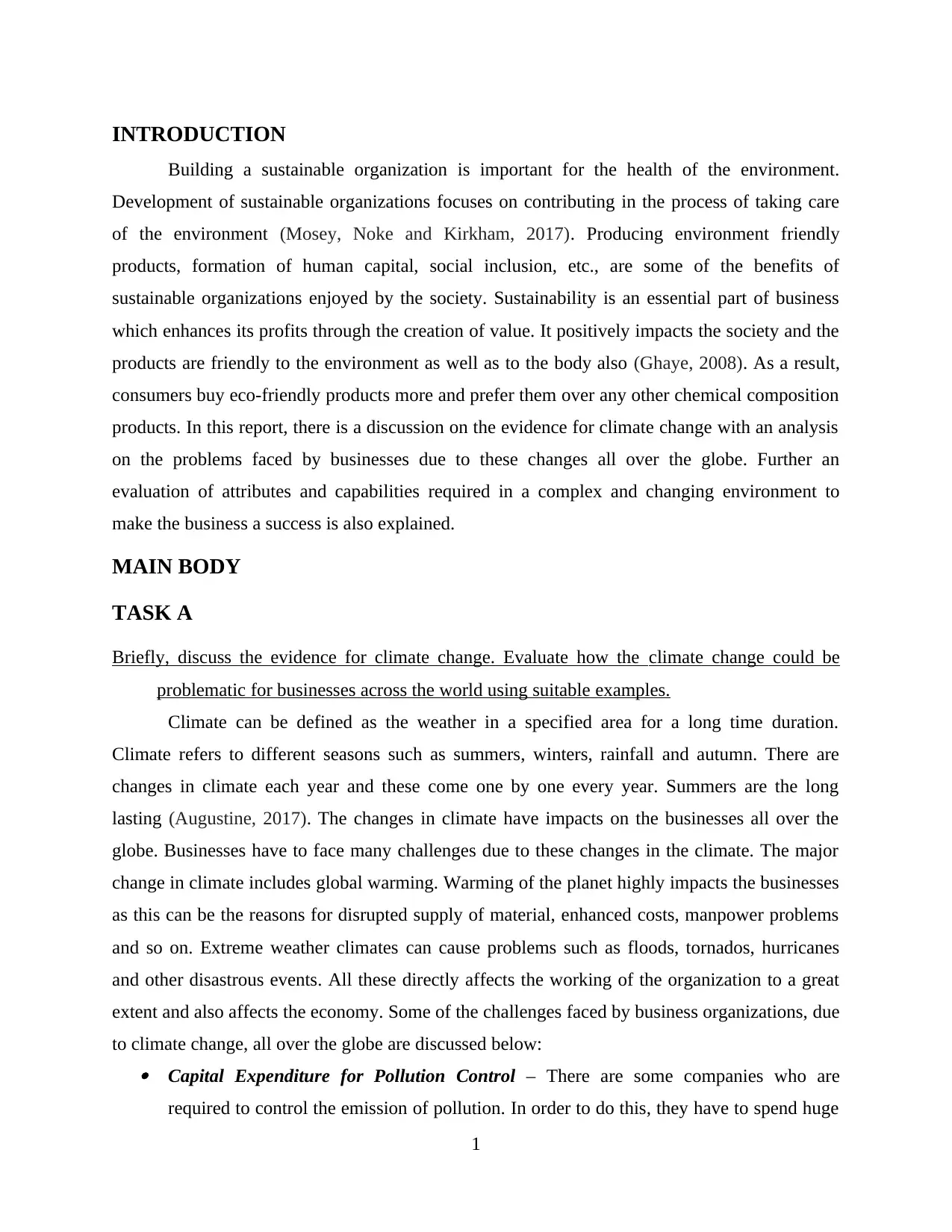
INTRODUCTION
Building a sustainable organization is important for the health of the environment.
Development of sustainable organizations focuses on contributing in the process of taking care
of the environment (Mosey, Noke and Kirkham, 2017). Producing environment friendly
products, formation of human capital, social inclusion, etc., are some of the benefits of
sustainable organizations enjoyed by the society. Sustainability is an essential part of business
which enhances its profits through the creation of value. It positively impacts the society and the
products are friendly to the environment as well as to the body also (Ghaye, 2008). As a result,
consumers buy eco-friendly products more and prefer them over any other chemical composition
products. In this report, there is a discussion on the evidence for climate change with an analysis
on the problems faced by businesses due to these changes all over the globe. Further an
evaluation of attributes and capabilities required in a complex and changing environment to
make the business a success is also explained.
MAIN BODY
TASK A
Briefly, discuss the evidence for climate change. Evaluate how the climate change could be
problematic for businesses across the world using suitable examples.
Climate can be defined as the weather in a specified area for a long time duration.
Climate refers to different seasons such as summers, winters, rainfall and autumn. There are
changes in climate each year and these come one by one every year. Summers are the long
lasting (Augustine, 2017). The changes in climate have impacts on the businesses all over the
globe. Businesses have to face many challenges due to these changes in the climate. The major
change in climate includes global warming. Warming of the planet highly impacts the businesses
as this can be the reasons for disrupted supply of material, enhanced costs, manpower problems
and so on. Extreme weather climates can cause problems such as floods, tornados, hurricanes
and other disastrous events. All these directly affects the working of the organization to a great
extent and also affects the economy. Some of the challenges faced by business organizations, due
to climate change, all over the globe are discussed below: Capital Expenditure for Pollution Control – There are some companies who are
required to control the emission of pollution. In order to do this, they have to spend huge
1
Building a sustainable organization is important for the health of the environment.
Development of sustainable organizations focuses on contributing in the process of taking care
of the environment (Mosey, Noke and Kirkham, 2017). Producing environment friendly
products, formation of human capital, social inclusion, etc., are some of the benefits of
sustainable organizations enjoyed by the society. Sustainability is an essential part of business
which enhances its profits through the creation of value. It positively impacts the society and the
products are friendly to the environment as well as to the body also (Ghaye, 2008). As a result,
consumers buy eco-friendly products more and prefer them over any other chemical composition
products. In this report, there is a discussion on the evidence for climate change with an analysis
on the problems faced by businesses due to these changes all over the globe. Further an
evaluation of attributes and capabilities required in a complex and changing environment to
make the business a success is also explained.
MAIN BODY
TASK A
Briefly, discuss the evidence for climate change. Evaluate how the climate change could be
problematic for businesses across the world using suitable examples.
Climate can be defined as the weather in a specified area for a long time duration.
Climate refers to different seasons such as summers, winters, rainfall and autumn. There are
changes in climate each year and these come one by one every year. Summers are the long
lasting (Augustine, 2017). The changes in climate have impacts on the businesses all over the
globe. Businesses have to face many challenges due to these changes in the climate. The major
change in climate includes global warming. Warming of the planet highly impacts the businesses
as this can be the reasons for disrupted supply of material, enhanced costs, manpower problems
and so on. Extreme weather climates can cause problems such as floods, tornados, hurricanes
and other disastrous events. All these directly affects the working of the organization to a great
extent and also affects the economy. Some of the challenges faced by business organizations, due
to climate change, all over the globe are discussed below: Capital Expenditure for Pollution Control – There are some companies who are
required to control the emission of pollution. In order to do this, they have to spend huge
1
Paraphrase This Document
Need a fresh take? Get an instant paraphrase of this document with our AI Paraphraser
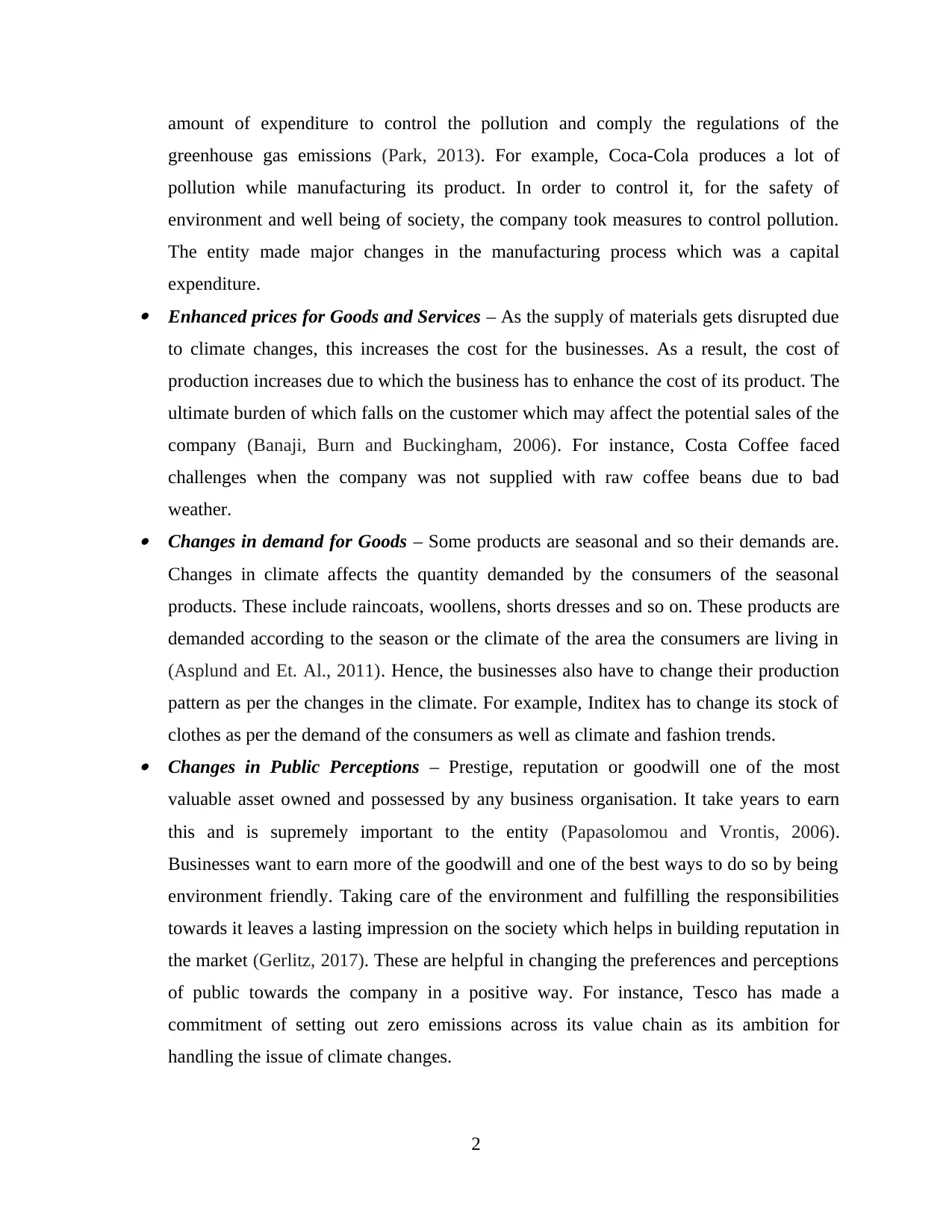
amount of expenditure to control the pollution and comply the regulations of the
greenhouse gas emissions (Park, 2013). For example, Coca-Cola produces a lot of
pollution while manufacturing its product. In order to control it, for the safety of
environment and well being of society, the company took measures to control pollution.
The entity made major changes in the manufacturing process which was a capital
expenditure. Enhanced prices for Goods and Services – As the supply of materials gets disrupted due
to climate changes, this increases the cost for the businesses. As a result, the cost of
production increases due to which the business has to enhance the cost of its product. The
ultimate burden of which falls on the customer which may affect the potential sales of the
company (Banaji, Burn and Buckingham, 2006). For instance, Costa Coffee faced
challenges when the company was not supplied with raw coffee beans due to bad
weather. Changes in demand for Goods – Some products are seasonal and so their demands are.
Changes in climate affects the quantity demanded by the consumers of the seasonal
products. These include raincoats, woollens, shorts dresses and so on. These products are
demanded according to the season or the climate of the area the consumers are living in
(Asplund and Et. Al., 2011). Hence, the businesses also have to change their production
pattern as per the changes in the climate. For example, Inditex has to change its stock of
clothes as per the demand of the consumers as well as climate and fashion trends. Changes in Public Perceptions – Prestige, reputation or goodwill one of the most
valuable asset owned and possessed by any business organisation. It take years to earn
this and is supremely important to the entity (Papasolomou and Vrontis, 2006).
Businesses want to earn more of the goodwill and one of the best ways to do so by being
environment friendly. Taking care of the environment and fulfilling the responsibilities
towards it leaves a lasting impression on the society which helps in building reputation in
the market (Gerlitz, 2017). These are helpful in changing the preferences and perceptions
of public towards the company in a positive way. For instance, Tesco has made a
commitment of setting out zero emissions across its value chain as its ambition for
handling the issue of climate changes.
2
greenhouse gas emissions (Park, 2013). For example, Coca-Cola produces a lot of
pollution while manufacturing its product. In order to control it, for the safety of
environment and well being of society, the company took measures to control pollution.
The entity made major changes in the manufacturing process which was a capital
expenditure. Enhanced prices for Goods and Services – As the supply of materials gets disrupted due
to climate changes, this increases the cost for the businesses. As a result, the cost of
production increases due to which the business has to enhance the cost of its product. The
ultimate burden of which falls on the customer which may affect the potential sales of the
company (Banaji, Burn and Buckingham, 2006). For instance, Costa Coffee faced
challenges when the company was not supplied with raw coffee beans due to bad
weather. Changes in demand for Goods – Some products are seasonal and so their demands are.
Changes in climate affects the quantity demanded by the consumers of the seasonal
products. These include raincoats, woollens, shorts dresses and so on. These products are
demanded according to the season or the climate of the area the consumers are living in
(Asplund and Et. Al., 2011). Hence, the businesses also have to change their production
pattern as per the changes in the climate. For example, Inditex has to change its stock of
clothes as per the demand of the consumers as well as climate and fashion trends. Changes in Public Perceptions – Prestige, reputation or goodwill one of the most
valuable asset owned and possessed by any business organisation. It take years to earn
this and is supremely important to the entity (Papasolomou and Vrontis, 2006).
Businesses want to earn more of the goodwill and one of the best ways to do so by being
environment friendly. Taking care of the environment and fulfilling the responsibilities
towards it leaves a lasting impression on the society which helps in building reputation in
the market (Gerlitz, 2017). These are helpful in changing the preferences and perceptions
of public towards the company in a positive way. For instance, Tesco has made a
commitment of setting out zero emissions across its value chain as its ambition for
handling the issue of climate changes.
2
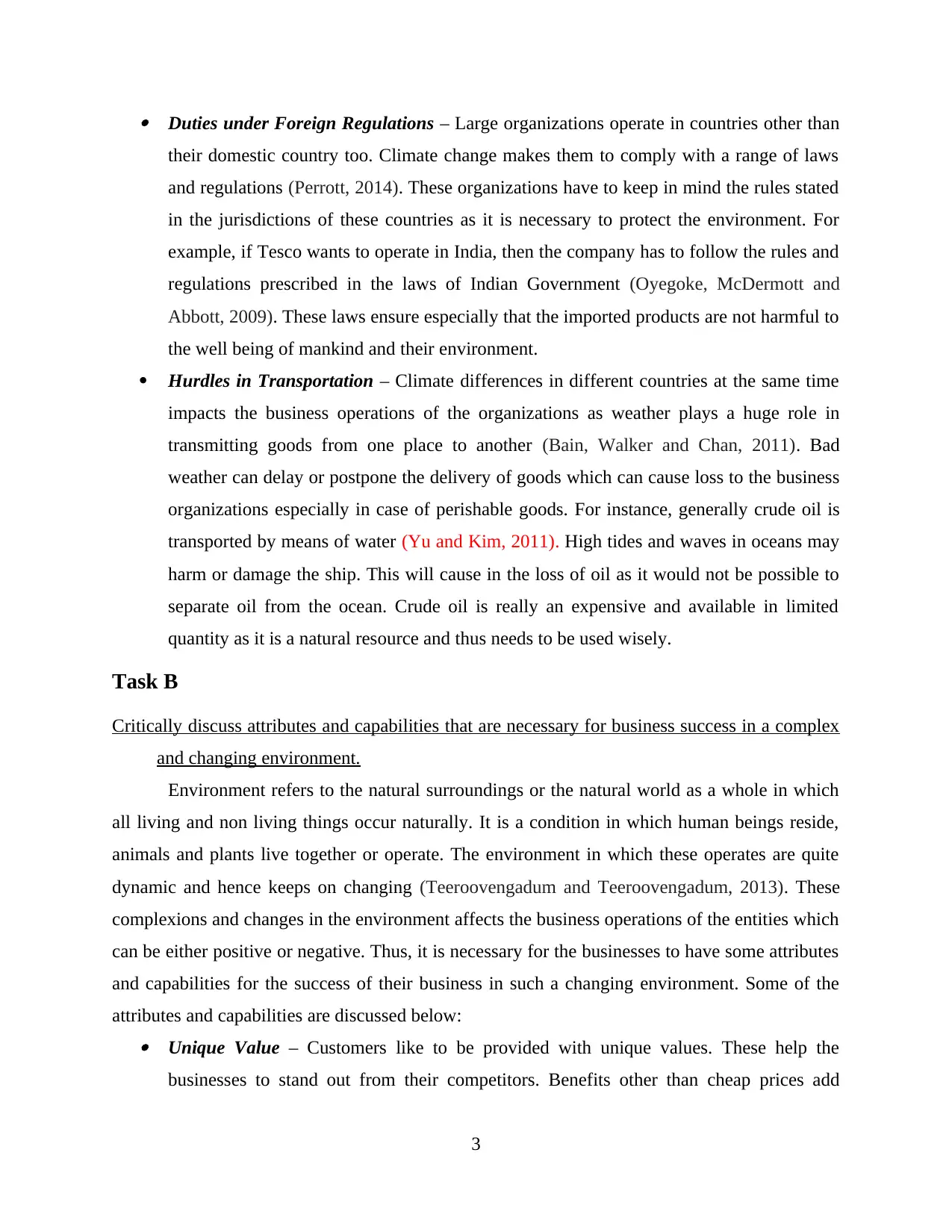
Duties under Foreign Regulations – Large organizations operate in countries other than
their domestic country too. Climate change makes them to comply with a range of laws
and regulations (Perrott, 2014). These organizations have to keep in mind the rules stated
in the jurisdictions of these countries as it is necessary to protect the environment. For
example, if Tesco wants to operate in India, then the company has to follow the rules and
regulations prescribed in the laws of Indian Government (Oyegoke, McDermott and
Abbott, 2009). These laws ensure especially that the imported products are not harmful to
the well being of mankind and their environment.
Hurdles in Transportation – Climate differences in different countries at the same time
impacts the business operations of the organizations as weather plays a huge role in
transmitting goods from one place to another (Bain, Walker and Chan, 2011). Bad
weather can delay or postpone the delivery of goods which can cause loss to the business
organizations especially in case of perishable goods. For instance, generally crude oil is
transported by means of water (Yu and Kim, 2011). High tides and waves in oceans may
harm or damage the ship. This will cause in the loss of oil as it would not be possible to
separate oil from the ocean. Crude oil is really an expensive and available in limited
quantity as it is a natural resource and thus needs to be used wisely.
Task B
Critically discuss attributes and capabilities that are necessary for business success in a complex
and changing environment.
Environment refers to the natural surroundings or the natural world as a whole in which
all living and non living things occur naturally. It is a condition in which human beings reside,
animals and plants live together or operate. The environment in which these operates are quite
dynamic and hence keeps on changing (Teeroovengadum and Teeroovengadum, 2013). These
complexions and changes in the environment affects the business operations of the entities which
can be either positive or negative. Thus, it is necessary for the businesses to have some attributes
and capabilities for the success of their business in such a changing environment. Some of the
attributes and capabilities are discussed below: Unique Value – Customers like to be provided with unique values. These help the
businesses to stand out from their competitors. Benefits other than cheap prices add
3
their domestic country too. Climate change makes them to comply with a range of laws
and regulations (Perrott, 2014). These organizations have to keep in mind the rules stated
in the jurisdictions of these countries as it is necessary to protect the environment. For
example, if Tesco wants to operate in India, then the company has to follow the rules and
regulations prescribed in the laws of Indian Government (Oyegoke, McDermott and
Abbott, 2009). These laws ensure especially that the imported products are not harmful to
the well being of mankind and their environment.
Hurdles in Transportation – Climate differences in different countries at the same time
impacts the business operations of the organizations as weather plays a huge role in
transmitting goods from one place to another (Bain, Walker and Chan, 2011). Bad
weather can delay or postpone the delivery of goods which can cause loss to the business
organizations especially in case of perishable goods. For instance, generally crude oil is
transported by means of water (Yu and Kim, 2011). High tides and waves in oceans may
harm or damage the ship. This will cause in the loss of oil as it would not be possible to
separate oil from the ocean. Crude oil is really an expensive and available in limited
quantity as it is a natural resource and thus needs to be used wisely.
Task B
Critically discuss attributes and capabilities that are necessary for business success in a complex
and changing environment.
Environment refers to the natural surroundings or the natural world as a whole in which
all living and non living things occur naturally. It is a condition in which human beings reside,
animals and plants live together or operate. The environment in which these operates are quite
dynamic and hence keeps on changing (Teeroovengadum and Teeroovengadum, 2013). These
complexions and changes in the environment affects the business operations of the entities which
can be either positive or negative. Thus, it is necessary for the businesses to have some attributes
and capabilities for the success of their business in such a changing environment. Some of the
attributes and capabilities are discussed below: Unique Value – Customers like to be provided with unique values. These help the
businesses to stand out from their competitors. Benefits other than cheap prices add
3
⊘ This is a preview!⊘
Do you want full access?
Subscribe today to unlock all pages.

Trusted by 1+ million students worldwide
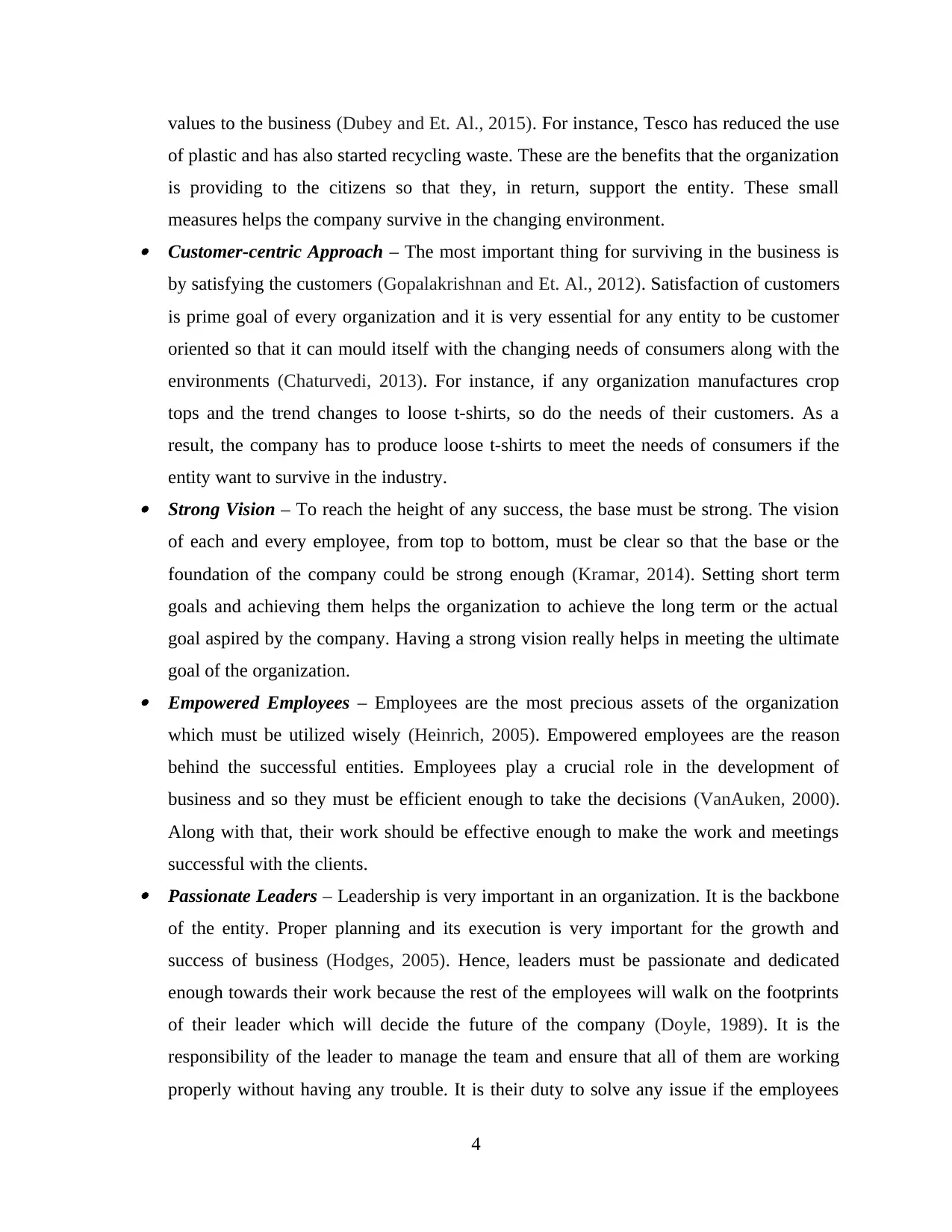
values to the business (Dubey and Et. Al., 2015). For instance, Tesco has reduced the use
of plastic and has also started recycling waste. These are the benefits that the organization
is providing to the citizens so that they, in return, support the entity. These small
measures helps the company survive in the changing environment. Customer-centric Approach – The most important thing for surviving in the business is
by satisfying the customers (Gopalakrishnan and Et. Al., 2012). Satisfaction of customers
is prime goal of every organization and it is very essential for any entity to be customer
oriented so that it can mould itself with the changing needs of consumers along with the
environments (Chaturvedi, 2013). For instance, if any organization manufactures crop
tops and the trend changes to loose t-shirts, so do the needs of their customers. As a
result, the company has to produce loose t-shirts to meet the needs of consumers if the
entity want to survive in the industry. Strong Vision – To reach the height of any success, the base must be strong. The vision
of each and every employee, from top to bottom, must be clear so that the base or the
foundation of the company could be strong enough (Kramar, 2014). Setting short term
goals and achieving them helps the organization to achieve the long term or the actual
goal aspired by the company. Having a strong vision really helps in meeting the ultimate
goal of the organization. Empowered Employees – Employees are the most precious assets of the organization
which must be utilized wisely (Heinrich, 2005). Empowered employees are the reason
behind the successful entities. Employees play a crucial role in the development of
business and so they must be efficient enough to take the decisions (VanAuken, 2000).
Along with that, their work should be effective enough to make the work and meetings
successful with the clients. Passionate Leaders – Leadership is very important in an organization. It is the backbone
of the entity. Proper planning and its execution is very important for the growth and
success of business (Hodges, 2005). Hence, leaders must be passionate and dedicated
enough towards their work because the rest of the employees will walk on the footprints
of their leader which will decide the future of the company (Doyle, 1989). It is the
responsibility of the leader to manage the team and ensure that all of them are working
properly without having any trouble. It is their duty to solve any issue if the employees
4
of plastic and has also started recycling waste. These are the benefits that the organization
is providing to the citizens so that they, in return, support the entity. These small
measures helps the company survive in the changing environment. Customer-centric Approach – The most important thing for surviving in the business is
by satisfying the customers (Gopalakrishnan and Et. Al., 2012). Satisfaction of customers
is prime goal of every organization and it is very essential for any entity to be customer
oriented so that it can mould itself with the changing needs of consumers along with the
environments (Chaturvedi, 2013). For instance, if any organization manufactures crop
tops and the trend changes to loose t-shirts, so do the needs of their customers. As a
result, the company has to produce loose t-shirts to meet the needs of consumers if the
entity want to survive in the industry. Strong Vision – To reach the height of any success, the base must be strong. The vision
of each and every employee, from top to bottom, must be clear so that the base or the
foundation of the company could be strong enough (Kramar, 2014). Setting short term
goals and achieving them helps the organization to achieve the long term or the actual
goal aspired by the company. Having a strong vision really helps in meeting the ultimate
goal of the organization. Empowered Employees – Employees are the most precious assets of the organization
which must be utilized wisely (Heinrich, 2005). Empowered employees are the reason
behind the successful entities. Employees play a crucial role in the development of
business and so they must be efficient enough to take the decisions (VanAuken, 2000).
Along with that, their work should be effective enough to make the work and meetings
successful with the clients. Passionate Leaders – Leadership is very important in an organization. It is the backbone
of the entity. Proper planning and its execution is very important for the growth and
success of business (Hodges, 2005). Hence, leaders must be passionate and dedicated
enough towards their work because the rest of the employees will walk on the footprints
of their leader which will decide the future of the company (Doyle, 1989). It is the
responsibility of the leader to manage the team and ensure that all of them are working
properly without having any trouble. It is their duty to solve any issue if the employees
4
Paraphrase This Document
Need a fresh take? Get an instant paraphrase of this document with our AI Paraphraser
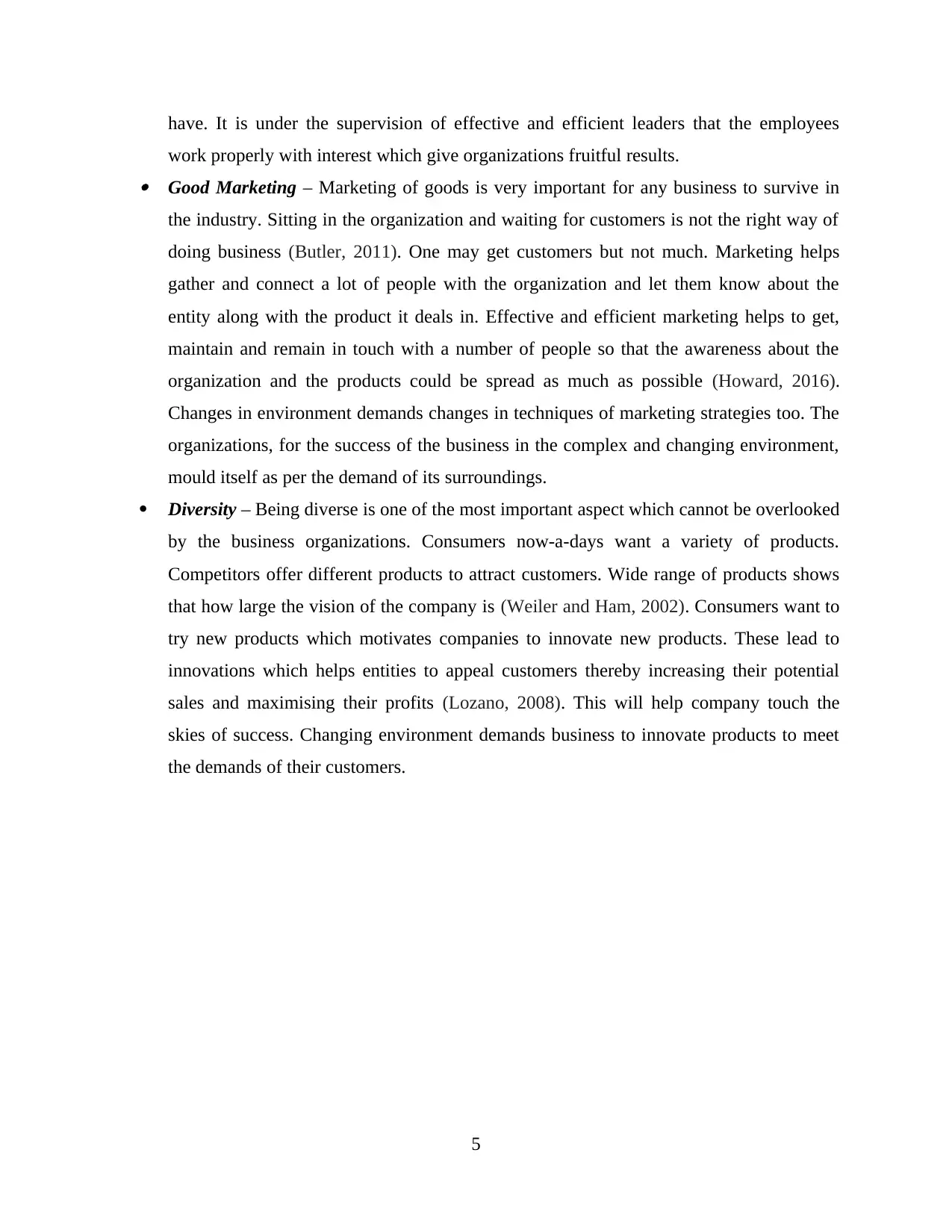
have. It is under the supervision of effective and efficient leaders that the employees
work properly with interest which give organizations fruitful results. Good Marketing – Marketing of goods is very important for any business to survive in
the industry. Sitting in the organization and waiting for customers is not the right way of
doing business (Butler, 2011). One may get customers but not much. Marketing helps
gather and connect a lot of people with the organization and let them know about the
entity along with the product it deals in. Effective and efficient marketing helps to get,
maintain and remain in touch with a number of people so that the awareness about the
organization and the products could be spread as much as possible (Howard, 2016).
Changes in environment demands changes in techniques of marketing strategies too. The
organizations, for the success of the business in the complex and changing environment,
mould itself as per the demand of its surroundings.
Diversity – Being diverse is one of the most important aspect which cannot be overlooked
by the business organizations. Consumers now-a-days want a variety of products.
Competitors offer different products to attract customers. Wide range of products shows
that how large the vision of the company is (Weiler and Ham, 2002). Consumers want to
try new products which motivates companies to innovate new products. These lead to
innovations which helps entities to appeal customers thereby increasing their potential
sales and maximising their profits (Lozano, 2008). This will help company touch the
skies of success. Changing environment demands business to innovate products to meet
the demands of their customers.
5
work properly with interest which give organizations fruitful results. Good Marketing – Marketing of goods is very important for any business to survive in
the industry. Sitting in the organization and waiting for customers is not the right way of
doing business (Butler, 2011). One may get customers but not much. Marketing helps
gather and connect a lot of people with the organization and let them know about the
entity along with the product it deals in. Effective and efficient marketing helps to get,
maintain and remain in touch with a number of people so that the awareness about the
organization and the products could be spread as much as possible (Howard, 2016).
Changes in environment demands changes in techniques of marketing strategies too. The
organizations, for the success of the business in the complex and changing environment,
mould itself as per the demand of its surroundings.
Diversity – Being diverse is one of the most important aspect which cannot be overlooked
by the business organizations. Consumers now-a-days want a variety of products.
Competitors offer different products to attract customers. Wide range of products shows
that how large the vision of the company is (Weiler and Ham, 2002). Consumers want to
try new products which motivates companies to innovate new products. These lead to
innovations which helps entities to appeal customers thereby increasing their potential
sales and maximising their profits (Lozano, 2008). This will help company touch the
skies of success. Changing environment demands business to innovate products to meet
the demands of their customers.
5
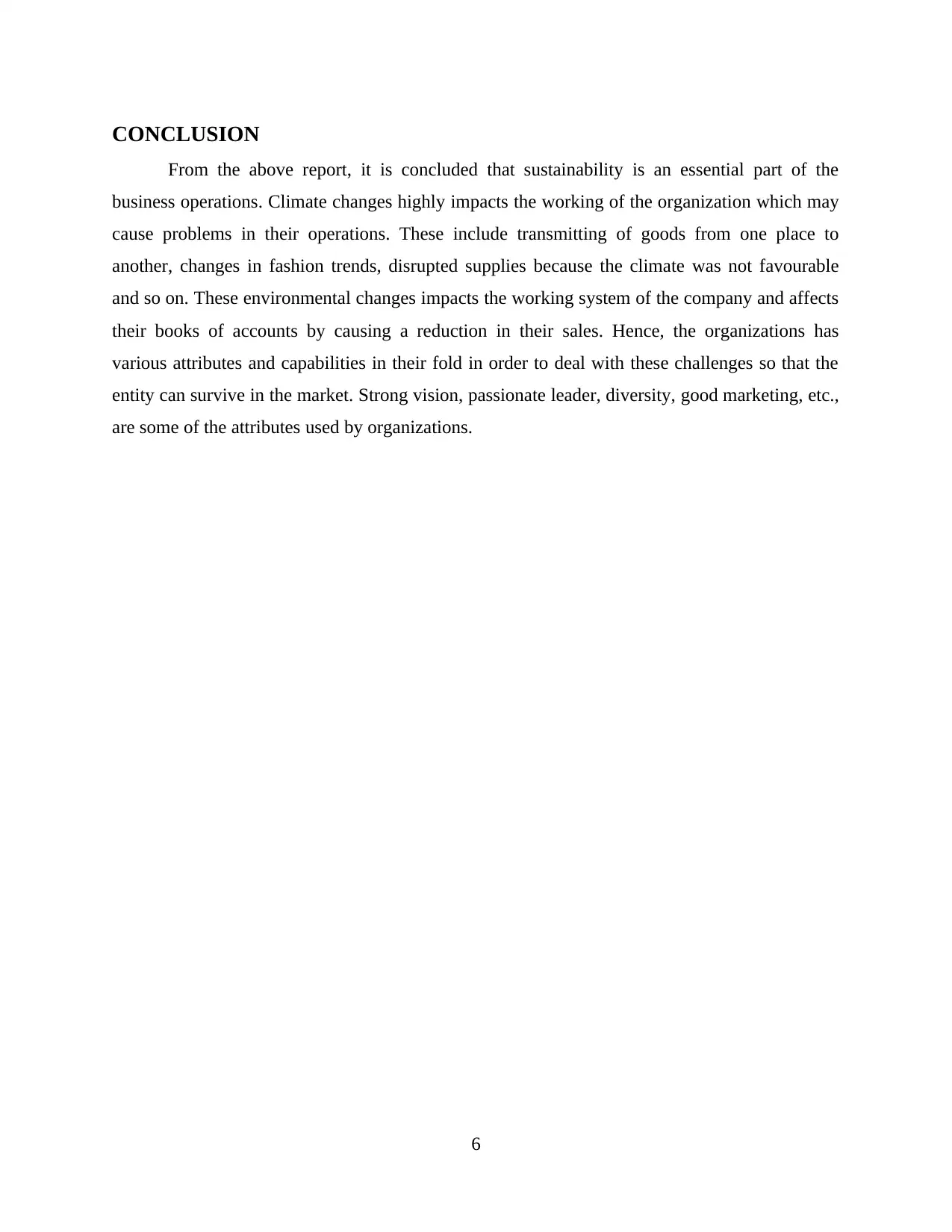
CONCLUSION
From the above report, it is concluded that sustainability is an essential part of the
business operations. Climate changes highly impacts the working of the organization which may
cause problems in their operations. These include transmitting of goods from one place to
another, changes in fashion trends, disrupted supplies because the climate was not favourable
and so on. These environmental changes impacts the working system of the company and affects
their books of accounts by causing a reduction in their sales. Hence, the organizations has
various attributes and capabilities in their fold in order to deal with these challenges so that the
entity can survive in the market. Strong vision, passionate leader, diversity, good marketing, etc.,
are some of the attributes used by organizations.
6
From the above report, it is concluded that sustainability is an essential part of the
business operations. Climate changes highly impacts the working of the organization which may
cause problems in their operations. These include transmitting of goods from one place to
another, changes in fashion trends, disrupted supplies because the climate was not favourable
and so on. These environmental changes impacts the working system of the company and affects
their books of accounts by causing a reduction in their sales. Hence, the organizations has
various attributes and capabilities in their fold in order to deal with these challenges so that the
entity can survive in the market. Strong vision, passionate leader, diversity, good marketing, etc.,
are some of the attributes used by organizations.
6
⊘ This is a preview!⊘
Do you want full access?
Subscribe today to unlock all pages.

Trusted by 1+ million students worldwide
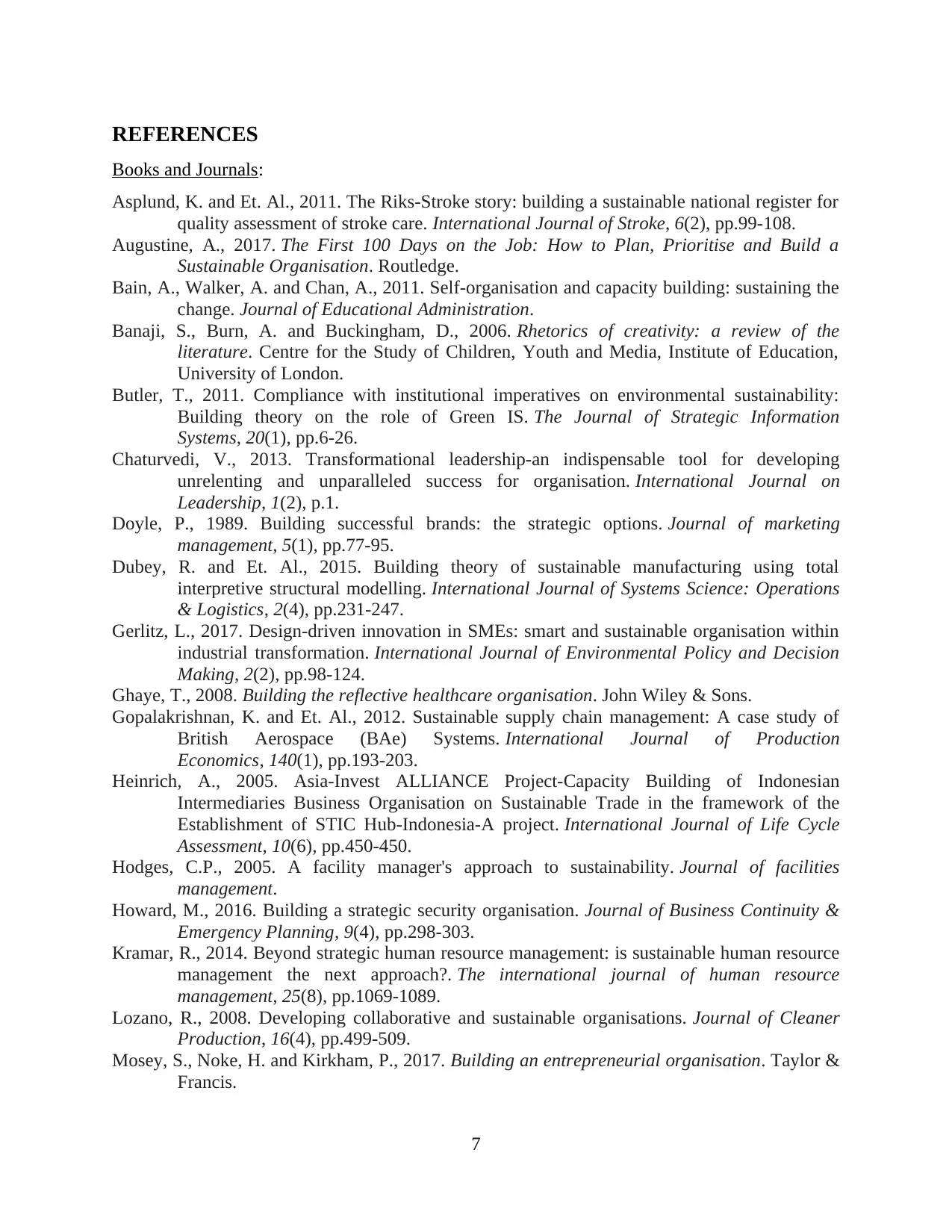
REFERENCES
Books and Journals:
Asplund, K. and Et. Al., 2011. The Riks-Stroke story: building a sustainable national register for
quality assessment of stroke care. International Journal of Stroke, 6(2), pp.99-108.
Augustine, A., 2017. The First 100 Days on the Job: How to Plan, Prioritise and Build a
Sustainable Organisation. Routledge.
Bain, A., Walker, A. and Chan, A., 2011. Self‐organisation and capacity building: sustaining the
change. Journal of Educational Administration.
Banaji, S., Burn, A. and Buckingham, D., 2006. Rhetorics of creativity: a review of the
literature. Centre for the Study of Children, Youth and Media, Institute of Education,
University of London.
Butler, T., 2011. Compliance with institutional imperatives on environmental sustainability:
Building theory on the role of Green IS. The Journal of Strategic Information
Systems, 20(1), pp.6-26.
Chaturvedi, V., 2013. Transformational leadership-an indispensable tool for developing
unrelenting and unparalleled success for organisation. International Journal on
Leadership, 1(2), p.1.
Doyle, P., 1989. Building successful brands: the strategic options. Journal of marketing
management, 5(1), pp.77-95.
Dubey, R. and Et. Al., 2015. Building theory of sustainable manufacturing using total
interpretive structural modelling. International Journal of Systems Science: Operations
& Logistics, 2(4), pp.231-247.
Gerlitz, L., 2017. Design-driven innovation in SMEs: smart and sustainable organisation within
industrial transformation. International Journal of Environmental Policy and Decision
Making, 2(2), pp.98-124.
Ghaye, T., 2008. Building the reflective healthcare organisation. John Wiley & Sons.
Gopalakrishnan, K. and Et. Al., 2012. Sustainable supply chain management: A case study of
British Aerospace (BAe) Systems. International Journal of Production
Economics, 140(1), pp.193-203.
Heinrich, A., 2005. Asia-Invest ALLIANCE Project-Capacity Building of Indonesian
Intermediaries Business Organisation on Sustainable Trade in the framework of the
Establishment of STIC Hub-Indonesia-A project. International Journal of Life Cycle
Assessment, 10(6), pp.450-450.
Hodges, C.P., 2005. A facility manager's approach to sustainability. Journal of facilities
management.
Howard, M., 2016. Building a strategic security organisation. Journal of Business Continuity &
Emergency Planning, 9(4), pp.298-303.
Kramar, R., 2014. Beyond strategic human resource management: is sustainable human resource
management the next approach?. The international journal of human resource
management, 25(8), pp.1069-1089.
Lozano, R., 2008. Developing collaborative and sustainable organisations. Journal of Cleaner
Production, 16(4), pp.499-509.
Mosey, S., Noke, H. and Kirkham, P., 2017. Building an entrepreneurial organisation. Taylor &
Francis.
7
Books and Journals:
Asplund, K. and Et. Al., 2011. The Riks-Stroke story: building a sustainable national register for
quality assessment of stroke care. International Journal of Stroke, 6(2), pp.99-108.
Augustine, A., 2017. The First 100 Days on the Job: How to Plan, Prioritise and Build a
Sustainable Organisation. Routledge.
Bain, A., Walker, A. and Chan, A., 2011. Self‐organisation and capacity building: sustaining the
change. Journal of Educational Administration.
Banaji, S., Burn, A. and Buckingham, D., 2006. Rhetorics of creativity: a review of the
literature. Centre for the Study of Children, Youth and Media, Institute of Education,
University of London.
Butler, T., 2011. Compliance with institutional imperatives on environmental sustainability:
Building theory on the role of Green IS. The Journal of Strategic Information
Systems, 20(1), pp.6-26.
Chaturvedi, V., 2013. Transformational leadership-an indispensable tool for developing
unrelenting and unparalleled success for organisation. International Journal on
Leadership, 1(2), p.1.
Doyle, P., 1989. Building successful brands: the strategic options. Journal of marketing
management, 5(1), pp.77-95.
Dubey, R. and Et. Al., 2015. Building theory of sustainable manufacturing using total
interpretive structural modelling. International Journal of Systems Science: Operations
& Logistics, 2(4), pp.231-247.
Gerlitz, L., 2017. Design-driven innovation in SMEs: smart and sustainable organisation within
industrial transformation. International Journal of Environmental Policy and Decision
Making, 2(2), pp.98-124.
Ghaye, T., 2008. Building the reflective healthcare organisation. John Wiley & Sons.
Gopalakrishnan, K. and Et. Al., 2012. Sustainable supply chain management: A case study of
British Aerospace (BAe) Systems. International Journal of Production
Economics, 140(1), pp.193-203.
Heinrich, A., 2005. Asia-Invest ALLIANCE Project-Capacity Building of Indonesian
Intermediaries Business Organisation on Sustainable Trade in the framework of the
Establishment of STIC Hub-Indonesia-A project. International Journal of Life Cycle
Assessment, 10(6), pp.450-450.
Hodges, C.P., 2005. A facility manager's approach to sustainability. Journal of facilities
management.
Howard, M., 2016. Building a strategic security organisation. Journal of Business Continuity &
Emergency Planning, 9(4), pp.298-303.
Kramar, R., 2014. Beyond strategic human resource management: is sustainable human resource
management the next approach?. The international journal of human resource
management, 25(8), pp.1069-1089.
Lozano, R., 2008. Developing collaborative and sustainable organisations. Journal of Cleaner
Production, 16(4), pp.499-509.
Mosey, S., Noke, H. and Kirkham, P., 2017. Building an entrepreneurial organisation. Taylor &
Francis.
7
Paraphrase This Document
Need a fresh take? Get an instant paraphrase of this document with our AI Paraphraser
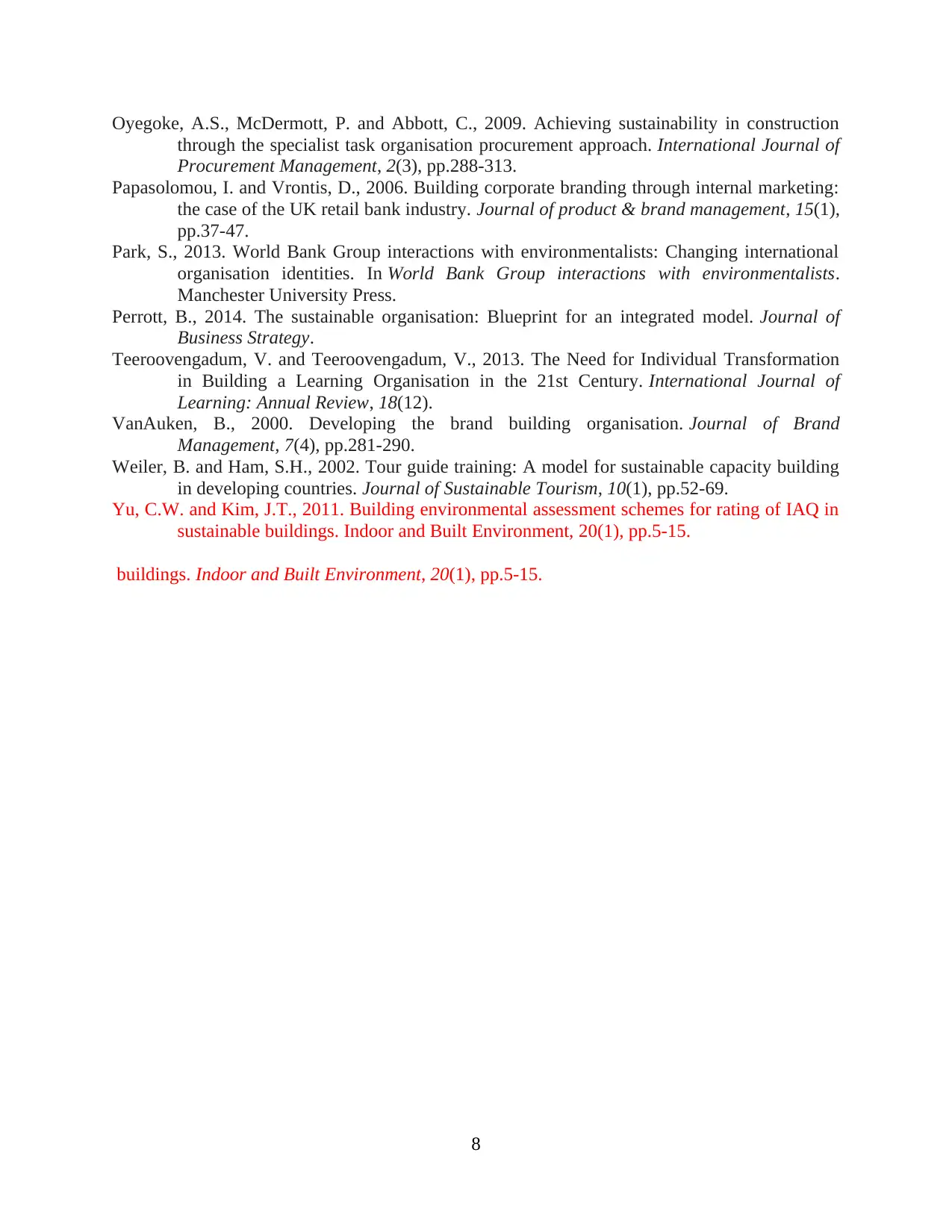
Oyegoke, A.S., McDermott, P. and Abbott, C., 2009. Achieving sustainability in construction
through the specialist task organisation procurement approach. International Journal of
Procurement Management, 2(3), pp.288-313.
Papasolomou, I. and Vrontis, D., 2006. Building corporate branding through internal marketing:
the case of the UK retail bank industry. Journal of product & brand management, 15(1),
pp.37-47.
Park, S., 2013. World Bank Group interactions with environmentalists: Changing international
organisation identities. In World Bank Group interactions with environmentalists.
Manchester University Press.
Perrott, B., 2014. The sustainable organisation: Blueprint for an integrated model. Journal of
Business Strategy.
Teeroovengadum, V. and Teeroovengadum, V., 2013. The Need for Individual Transformation
in Building a Learning Organisation in the 21st Century. International Journal of
Learning: Annual Review, 18(12).
VanAuken, B., 2000. Developing the brand building organisation. Journal of Brand
Management, 7(4), pp.281-290.
Weiler, B. and Ham, S.H., 2002. Tour guide training: A model for sustainable capacity building
in developing countries. Journal of Sustainable Tourism, 10(1), pp.52-69.
Yu, C.W. and Kim, J.T., 2011. Building environmental assessment schemes for rating of IAQ in
sustainable buildings. Indoor and Built Environment, 20(1), pp.5-15.
buildings. Indoor and Built Environment, 20(1), pp.5-15.
8
through the specialist task organisation procurement approach. International Journal of
Procurement Management, 2(3), pp.288-313.
Papasolomou, I. and Vrontis, D., 2006. Building corporate branding through internal marketing:
the case of the UK retail bank industry. Journal of product & brand management, 15(1),
pp.37-47.
Park, S., 2013. World Bank Group interactions with environmentalists: Changing international
organisation identities. In World Bank Group interactions with environmentalists.
Manchester University Press.
Perrott, B., 2014. The sustainable organisation: Blueprint for an integrated model. Journal of
Business Strategy.
Teeroovengadum, V. and Teeroovengadum, V., 2013. The Need for Individual Transformation
in Building a Learning Organisation in the 21st Century. International Journal of
Learning: Annual Review, 18(12).
VanAuken, B., 2000. Developing the brand building organisation. Journal of Brand
Management, 7(4), pp.281-290.
Weiler, B. and Ham, S.H., 2002. Tour guide training: A model for sustainable capacity building
in developing countries. Journal of Sustainable Tourism, 10(1), pp.52-69.
Yu, C.W. and Kim, J.T., 2011. Building environmental assessment schemes for rating of IAQ in
sustainable buildings. Indoor and Built Environment, 20(1), pp.5-15.
buildings. Indoor and Built Environment, 20(1), pp.5-15.
8
1 out of 11
Related Documents
Your All-in-One AI-Powered Toolkit for Academic Success.
+13062052269
info@desklib.com
Available 24*7 on WhatsApp / Email
![[object Object]](/_next/static/media/star-bottom.7253800d.svg)
Unlock your academic potential
Copyright © 2020–2025 A2Z Services. All Rights Reserved. Developed and managed by ZUCOL.





